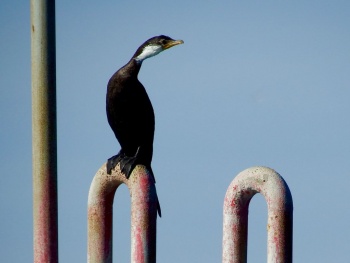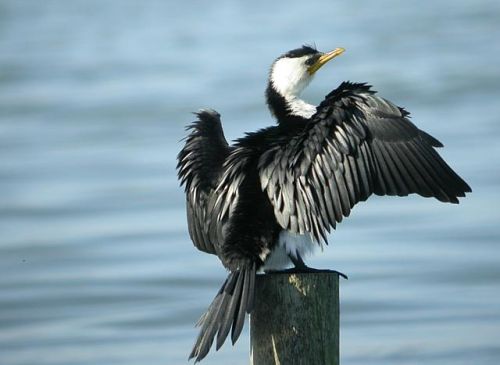(→External Links: Multiple GSearches combined) |
|||
| (22 intermediate revisions by 8 users not shown) | |||
| Line 1: | Line 1: | ||
| − | + | '''Alternative Names: Little Shag''' ([[New Zealand]]) | |
| − | [[Image:Little_Pied_Cormorant.jpg|thumb| | + | [[Image:Little_Pied_Cormorant.jpg|thumb|500px|right|Photo by {{user|Tannin|Tannin}} <br />[[Victoria]], [[Australia]], July 2003]] |
| + | ;[[:Category:Microcarbo|Microcarbo]] melanoleucos | ||
| + | |||
==Identification== | ==Identification== | ||
| − | + | [[Image:DSCF89201.jpg|thumb|350px|right|Subspecies ''brevirostris'', White-throated phase <br />Photo by {{user|craigwilson|craigwilson}}<br />Otago Harbour, [[New Zealand]], April 2017]] | |
| − | + | 55–65 cm (21¾-26 in) | |
| − | + | *Black upperparts | |
| + | *White underparts | ||
| + | *Short yellow bill | ||
| + | *Long tail | ||
| + | *Black feet<br /> | ||
| + | Juvenile has all black plumage | ||
==Distribution== | ==Distribution== | ||
| − | + | [[Indonesia]], [[Solomon Islands]], [[Australia]] and [[New Zealand]]. | |
==Taxonomy== | ==Taxonomy== | ||
| + | Formerly placed in genus [[:Category:Phalacrocorax|Phalacrocorax]]. | ||
| + | ====Subspecies==== | ||
| + | [[Image:DSCF8967.jpg|thumb|350px|right|Subspecies ''brevirostris'', Pied phase <br />Photo by {{user|craigwilson|craigwilson}}<br />Otago Harbour, [[New Zealand]], April 2017]] | ||
| + | There are 3 subspecies<sup>[[#References|[1]]]</sup>: | ||
| + | *''M. m. melanoleucos'': | ||
| + | :*[[Lesser Sundas]] to [[Solomon Islands]], [[Australia]] and [[Tasmania]] | ||
| + | *''M. m. brevicauda'': | ||
| + | :*Rennel Island (Solomon Islands) | ||
| + | *''M. m. brevirostris'': | ||
| + | :*[[New Zealand]], Stewart and Campbell islands | ||
==Habitat== | ==Habitat== | ||
| − | + | Lakes, rivers, swamps etc. They prefer fresh water, but are often seen on the coast too. | |
==Behaviour== | ==Behaviour== | ||
| − | + | ====Diet==== | |
| − | + | Diet consists of aquatic animals, from insects to fish including freshwater crayfish, shrimps and prawns. | |
| + | ====Breeding==== | ||
| + | The nest is a flat platform of sticks, lined with green leaves and is usually placed in a tree. Both adults share in egg incubation and care of the 3-4 young. | ||
| + | ==Gallery== | ||
| + | Click on photo for larger image | ||
| + | <gallery> | ||
| + | Image:Little Pied Cormorants.JPG|Juveniles<br />Photo by {{user|Ken+Doy|Ken Doy}}<br />Sandy Camp Rd Wetlands, [[Queensland]], [[Australia]], March 2016 | ||
| + | Image:Little -Pied Cormorant.JPG|Subspecies ''melanoleucos''<br />Photo by {{user|Ken+Doy|Ken Doy}}<br />Wellington Point, Brisbane, [[Queensland]], March 2017 | ||
| + | </gallery> | ||
| + | ==References== | ||
| + | #{{Ref-Clements6thAug16}}#BirdsinBackyards | ||
| + | #Handbook of the Birds of the World Alive (retrieved March 2017) | ||
| + | {{ref}} | ||
| + | ==External Links== | ||
| + | {{GSearch|"Microcarbo melanoleucos" {{!}} "Phalacrocorax melanoleucos" {{!}} "Little Pied Cormorant" {{!}} "Little Shag"}} | ||
| + | <br /> | ||
| + | Search specifically for Little Shag: | ||
| + | {{GSearch|"Little Shag"}} | ||
| + | {{GS-checked}}1 | ||
| + | <br /> | ||
| + | <br /> | ||
| − | + | [[Category:Birds]] [[Category:Microcarbo]] | |
| − | |||
| − | |||
| − | |||
| − | |||
| − | [[Category: | ||
Latest revision as of 12:19, 24 January 2023
Alternative Names: Little Shag (New Zealand)
- Microcarbo melanoleucos
Identification

Photo by craigwilson
Otago Harbour, New Zealand, April 2017
55–65 cm (21¾-26 in)
- Black upperparts
- White underparts
- Short yellow bill
- Long tail
- Black feet
Juvenile has all black plumage
Distribution
Indonesia, Solomon Islands, Australia and New Zealand.
Taxonomy
Formerly placed in genus Phalacrocorax.
Subspecies
There are 3 subspecies[1]:
- M. m. melanoleucos:
- M. m. brevicauda:
- Rennel Island (Solomon Islands)
- M. m. brevirostris:
- New Zealand, Stewart and Campbell islands
Habitat
Lakes, rivers, swamps etc. They prefer fresh water, but are often seen on the coast too.
Behaviour
Diet
Diet consists of aquatic animals, from insects to fish including freshwater crayfish, shrimps and prawns.
Breeding
The nest is a flat platform of sticks, lined with green leaves and is usually placed in a tree. Both adults share in egg incubation and care of the 3-4 young.
Gallery
Click on photo for larger image
Juveniles
Photo by Ken Doy
Sandy Camp Rd Wetlands, Queensland, Australia, March 2016Subspecies melanoleucos
Photo by Ken Doy
Wellington Point, Brisbane, Queensland, March 2017
References
- Clements, J. F., T. S. Schulenberg, M. J. Iliff, D. Roberson, T. A. Fredericks, B. L. Sullivan, and C. L. Wood. 2016. The eBird/Clements checklist of birds of the world: v2016, with updates to August 2016. Downloaded from http://www.birds.cornell.edu/clementschecklist/download/
- BirdsinBackyards
- Handbook of the Birds of the World Alive (retrieved March 2017)
Recommended Citation
- BirdForum Opus contributors. (2024) Little Pied Cormorant. In: BirdForum, the forum for wild birds and birding. Retrieved 3 June 2024 from https://www.birdforum.net/opus/Little_Pied_Cormorant
External Links
Search specifically for Little Shag:
GSearch checked for 2020 platform.1







